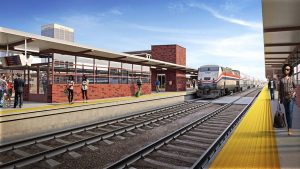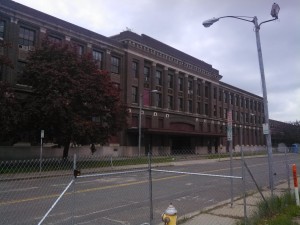UPDATED: One Late Arrival Expected at Springfield’s Union Station…
UPDATED 7/1/2016 8:36AM: To include comments from Amtrak about the platform delay and station renovations.
SPRINGFIELD—Less than a year out from its anticipated opening, one part of Union Station will not go online alongside the rest of the terminal. A new rail platform fully compliant with the Americans with Disabilities Act (ADA) will not be completed when the facility opens either late this year or early next.
Instead, Amtrak passengers are expected to continue using the railroad’s existing stairwell and elevator to reach the platform level. The feds rejected a waiver that would have retained the Massachusetts Department of Transportation original design, prompting a return to the drawing board and another disappointment for the renovation in its final stretch.
Springfield Chief Development Officer Kevin Kennedy said it was, “another little bump in the road.”
The delay comes after the city revealed dozens of period wooden benches, intended for the station’s main hall, had disappeared. Thievery was blamed.
As the platform will likely open only six months behind the station itself, the delay seems minor for a project whose history dates back decades. Kennedy’s former boss, US Representative Richard Neal, kicked off his campaign for city council there in the late 1970’s promising to reopen the then-recently shuttered terminal.
.@RepRichardNeal says he first announced for #SpringfieldMA City Council at #UnionStationSpfld in 1970's. #spfldpoli
— Matt Szafranski (@MSzafranski413) June 22, 2015
At a press conference Tuesday at the city’s Tapley Street building, Kennedy and Springfield Redevelopment Authority Executive Director Christopher Moskal said MassDOT had designed the platform six inches too narrow under Federal Railroad Administration ADA rules. High-level platforms level with passenger trains must have six feet between the platform’s edge and its elevators or stairwells. Amtrak and MassDOT unsuccessful sought a waiver from the FRA.

Springfield Chief Development Officer Kevin Kennedy in 2011 with Mayor Domenic Sarno and US Rep. Richard Neal. (WMassP&I)
Kennedy and Moskal said the redesign was already underway. The new platform, built on an existing one closer to the station—Amtrak’s current facility adjoins the one closest to Lyman Street—should, however, open well before the Hartford Line, Connecticut’s planned commuter service between New Haven and Springfield, starts up in January 2018.
Rehabbing the tunnel and the connecting stairwells and elevators that bring passengers up to track level has been among the projects more challenging components, though. City lawyers have said obtaining easements to waterproof the long-neglected tunnel required onerous negotiations with Amtrak and CSX, whose tracks also traverse the property.
Kennedy and Moskal claimed MassDOT was responsible for paying for the redesign and added construction costs. MassDOT could not be immediately reached for comment.
Cost overruns are a huge concern. The federal government put Union Station on an extremely short leash with frequent audits and compliance checks to avoid the fiasco that accompanied the late 1990’s effort to renovate the station. A grandiose proposal to bring buses to track level and build a Washington Union Station-style mall collapsed under the weight of its own ambition and a federal investigation into personnel at the Pioneer Valley Transit Authority, then the project’s lead agency.
The ride has been anything but smooth this time around. The baggage building, demolished to make room for the bus bays and parking garage, was found to be moonlighting as a retaining wall for the railroad viaduct. Special measures were needed to support the track structure. Springfield’s fiendishly complex geology and soil scrapped a modern block-long all-in-one bus station and parking structure. To stay on budget, uncovered bus bays and an ungainly garage are being built instead.
“Experience has taught me, with this project, not to be disappointed with anything,” Kennedy said Tuesday.
Still, officials insist other things are going to plan. Though he demurred on naming potential tenants, Kennedy said negotiations to fill retail and office space were going well. Amtrak will lease space, but a railroad spokeperson told WMassP&I, “as soon as the platform is completed and open, Amtrak will move passenger operations into the renovated station.”
Union Station stands as perhaps the surest bet as a transformative project in the city, particularly for an area largely felled by Springfield’s largest spasm of downtown urban renewal 50-plus years ago. Parking lot ridden and sporting uninspiring architecture, the blocks surrounding the station and beyond could be transformed with expanded rail service and transit-oriented development.
Once the new platform is finished, the stairway to Amtrak’s current facility will close in order to refurbish the Lyman Street end of the passenger tunnel. Amtrak will continue to use it for non-passenger purposes. Amtrak spokesperson Mike Talbert told WMassP&I in an email that its current facility will be used for police mechanical and shipping purposes.
Moskal said only one platform—and with it two tracks—are part of current plans, but the project did rehab the inside of the stairwells to other platforms. MassDOT, he said, hopes to open those up with new high-level platforms, ahead of additional hoped-for rail service, not just south to New Haven, but to the north and east.

